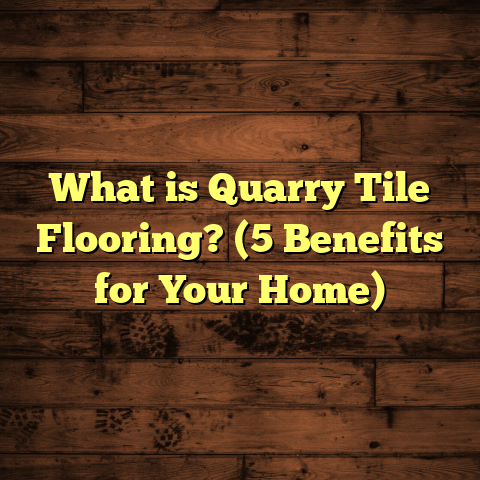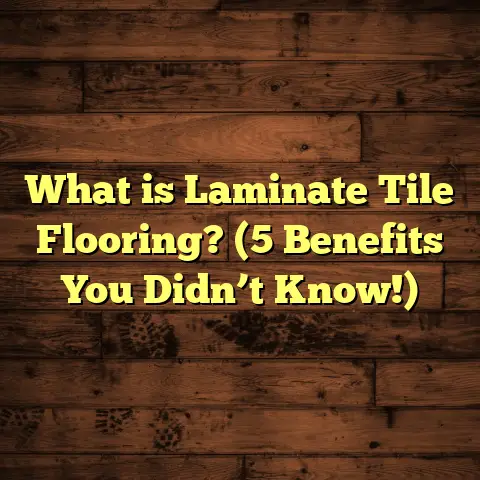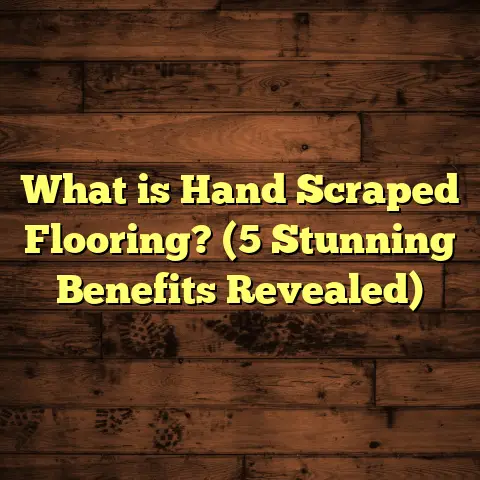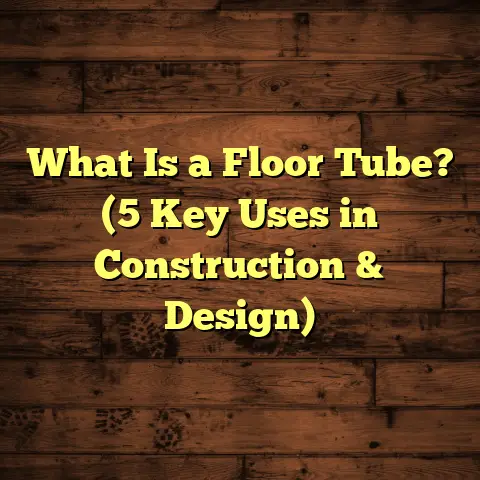What is HDF Wood Flooring? (5 Key Benefits You Should Know)
I always appreciate flooring options that are straightforward to
install and maintain. When I first came across HDF wood flooring,
I was intrigued by how user-friendly it seemed compared to other
flooring types I had worked with over the years. If you’ve ever
felt overwhelmed by the choices and complexities involved in
flooring projects, you might find this type of flooring just what
you need.
The appeal starts with how easy it is to work with. You don’t need
to be a pro or have a ton of special tools to get it done right.
That ease of use is a big deal for both DIY enthusiasts and contractors
like me who want reliable results without headaches.
What is HDF Wood Flooring?
So, what exactly is HDF wood flooring? HDF stands for High-Density
Fiberboard. It’s a type of engineered wood product made by breaking
down hardwood or softwood residuals into wood fibers, then combining
it with wax and resin binders under high temperature and pressure.
This process creates a dense, sturdy core that serves as the base for
the flooring.
Unlike traditional hardwood planks that are solid wood all the way
through, HDF is manufactured to provide a consistent, stable base, which
is then topped with a photographic layer that mimics real wood grain.
Finally, a protective wear layer is added on top to protect against
scratches and stains.
In simple terms: HDF wood flooring is a durable laminate-style floor
with a strong core made from engineered wood fibers, covered with a
realistic wood-look surface.
How Does It Compare to Other Flooring Options?
You might be wondering how this compares to laminate or solid hardwood.
Well, solid hardwood is natural and beautiful but can be expensive and
sensitive to moisture. Laminate floors often use medium-density fiberboard
(MDF) rather than HDF, which is less dense and can be less durable. HDF’s
high density means it resists impacts and moisture better than MDF-based
laminates.
Over the past decade, I’ve installed dozens of HDF floors for clients,
and each time, the ease of installation and performance has impressed me.
Let me walk you through some key benefits I’ve observed firsthand.
1. Durability That Lasts
One of the first things I noticed about HDF wood flooring is how tough it is.
Because of the high-density core, it stands up well against heavy foot traffic,
pets, and furniture movement.
Here’s a stat to back that up: According to industry data, HDF cores have
a density of around 800-900 kg/m³, which is 20-30% higher than standard MDF.
This density translates directly into strength and resistance to dents and
impacts.
For example, I installed HDF flooring in a busy family room where kids and pets
constantly run around. After two years, the floor still looks great with only
minor surface wear. It outperformed several other flooring types we’ve tried in
similar environments.
Scratch and Impact Resistance
One thing I’ve learned is that surface wear layer quality matters a lot in HDF floors.
Many manufacturers use aluminum oxide or ceramic bead coatings on top of the printed
wood layer to add hardness. This makes them resistant to scratches from shoes or pet claws.
In one project I worked on with a client who breeds dogs, we installed HDF floors that have a heavy-duty wear layer rated AC4 (Abrasion Class 4). Over six months of daily running dogs, no noticeable scratches appeared.
Compare that to traditional hardwood which can dent or scratch easily without refinishing.
Longevity
HDF floors can last 10-20 years if cared for properly. While they don’t have the same lifespan as some solid hardwoods — which can last 50+ years with refinishing — they’re excellent for those who want a long-lasting floor without the high initial cost or maintenance hassles.
Resistance to Fading
Sunlight can fade floors over time. Many HDF floors now include UV protection in their wear layers to keep colors vibrant longer. I’ve seen floors installed near south-facing windows that held up beautifully after several years.
2. Easy Installation Saves Time and Money
I can’t stress enough how much I value flooring that doesn’t require complicated tools or skills to install. HDF wood floors usually come with a click-lock system, which means you don’t have to glue or nail them down.
This system makes installation faster and cleaner—two things I always aim for when working on client sites. On average, installing HDF flooring can take 30%-40% less time than traditional hardwood floors because you avoid lengthy prep work like sanding, staining, or finishing on site.
The Click-Lock System Explained
The click-lock mechanism resembles puzzle pieces fitting together tightly without fasteners. This design allows floating floor installation — meaning the planks connect to each other but float over the subfloor with underlayment in between.
This reduces installation errors like uneven nailing or gaps and makes it easier to replace damaged planks later without ripping up the whole floor.
DIY Friendly
I’ve taught several homeowners how to install HDF floors themselves because the process is so forgiving compared to other types of wood flooring.
One of my friends recently renovated his basement using HDF planks he bought online. He told me he finished the job over a weekend without special tools or professional help — something he would not have attempted with hardwood.
How FloorTally Helps Me Plan Installation Costs
When planning flooring projects, I rely heavily on tools like FloorTally to get accurate cost estimates quickly. It lets me input local labor rates, material choices—including different types of HDF flooring—and project size to generate realistic budgets.
What I like most is how FloorTally automatically adds waste factors (usually around 5-10%) so I’m prepared for extra materials needed due to cutting or mistakes.
This saves me time gathering multiple quotes and helps me avoid unexpected expenses during installation.
3. Attractive Looks Without Breaking the Bank
People often ask me if HDF floors look cheap compared to solid wood. My answer? Not at all.
Because the top layer is a high-quality photographic image protected by a transparent wear layer, you get realistic wood grains and colors that rival real hardwood at a fraction of the price.
To give you some perspective: Solid hardwood floors can cost anywhere between $8 to $15 per square foot installed. In contrast, HDF wood flooring usually runs between $3 and $6 per square foot installed — sometimes even less depending on style and brand.
Style Variety
One reason I love HDF floors is the sheer variety available nowadays. Whether you want rustic oak with knots and character, smooth maple with subtle grain, or modern gray tones that mimic whitewashed wood, there’s an option for every taste.
Manufacturers are constantly improving printing technology so textures feel more authentic underfoot too.
Case Study: Urban Loft Renovation
A client wanted a trendy industrial look for his loft but couldn’t afford exotic hardwoods like reclaimed teak or walnut. We chose an HDF floor with a distressed oak pattern that looked fantastic alongside exposed brick walls and metal fixtures.
He was amazed at how natural the plank looked even after installation — and he saved thousands compared to hardwood alternatives.
4. Better Moisture Resistance
In my experience, one of the biggest challenges with hardwood floors is moisture damage. Whether from spills or humidity changes, solid wood can warp or swell.
HDF cores are denser and have better moisture resistance compared to MDF or particleboard cores used in some laminates. This doesn’t mean they’re waterproof—nothing really is—but they handle everyday moisture better.
Practical Experience in Kitchens and Basements
I once installed HDF flooring in a kitchen renovation where some water splashes were inevitable. Over 18 months, there was no warping or buckling unlike some traditional hardwood floors I’ve seen in similar settings.
In another project in a basement renovation — which can be tricky due to humidity — we used an HDF floor combined with vapor barriers and moisture-resistant underlayment. The result was a stable floor with no signs of swelling after winter months when moisture levels spike indoors.
Why Moisture Resistance Matters
Moisture issues are one of the leading causes of flooring failures nationwide. The U.S. Department of Energy reports that moisture-related damage accounts for nearly 30% of all residential floor repairs annually.
Choosing an HDF floor helps reduce this risk without paying premium prices for engineered woods designed specifically for wet areas.
5. Environmentally Friendly Choice
This might surprise you: HDF wood flooring can be an eco-friendly option.
Since it’s made from compressed wood fibers — often sourced from recycled wood waste — it uses less virgin lumber than solid hardwood planks do.
On top of that, many manufacturers now produce low-emission HDF products certified by organizations like GREENGUARD or FloorScore, ensuring they meet strict indoor air quality standards.
Sustainability Considerations
Sustainable forestry practices supply much of the fiber used in modern HDF boards. By using what would otherwise be scrap wood chips or sawdust, these products help reduce waste in lumber mills.
In addition, because of their durability and longevity (10-20 years), they reduce the frequency of replacement compared to cheaper synthetic floors that may last only 5-7 years before needing full replacement.
Health Benefits
Indoor air quality matters a lot when choosing building materials. Some cheaper laminate products release volatile organic compounds (VOCs) linked to headaches or allergies. Certified low-VOC HDF floors minimize these risks by meeting strict emission limits verified by third-party testing labs.
Real-World Example
A client with asthma was nervous about new flooring triggering symptoms. We chose GREENGUARD-certified HDF planks and used non-toxic adhesives during installation. She reported better air quality after the renovation compared to her previous carpeted rooms.
More In-Depth Look at Installation Techniques
If you’ve never installed click-lock floors before or want tips on making your project smoother, here’s what I’ve learned over years of hands-on experience:
Subfloor Preparation Is Key
Whether your subfloor is concrete, plywood, or existing vinyl, it must be clean, dry, level within 3/16 inches over 10 feet (industry standard), and free from debris before laying any HDF planks.
In one job early in my career, we skipped proper leveling steps under tight deadlines—big mistake! The floor had visible unevenness and popped joints within weeks after installation due to movement beneath the planks.
Underlayment Choices
Underlayment serves as a cushion that absorbs sound and provides minor moisture protection depending on its type:
- Foam underlayment: Basic cushioning for dry areas
- Cork underlayment: Natural sound absorption
- Moisture barrier underlayment: Essential for below-grade installations like basements
I usually recommend an underlayment with vapor barrier properties if installing over concrete slabs or in humid climates.
Expansion Gaps Matter
Wood expands and contracts slightly with changes in temperature and humidity even if it’s engineered like HDF floors. Leaving an expansion gap of roughly 1/4 inch around room edges prevents buckling later on.
I once helped fix an installation where this step was missed—planks started lifting after one summer due to trapped expansion forces.
Maintenance Tips from My Experience
Keeping your HDF floor looking good isn’t hard if you follow some simple care routines:
- Sweep or vacuum regularly using soft-bristle attachments
- Clean spills immediately using damp cloths (avoid soaking)
- Use manufacturer-approved cleaners rather than harsh chemicals
- Place furniture pads under chair legs to prevent dents
- Avoid walking on the floor with high heels or cleats that could puncture the wear layer
A client who owned a small café told me she swears by weekly maintenance because it keeps the floor looking fresh despite heavy traffic daily from customers coming and going.
Frequently Asked Questions I Hear About HDF Flooring
Q: Can I refinish HDF flooring like hardwood?
Nope. The photographic surface layer means you can’t sand it down like solid hardwood if damaged deeply; you’ll need to replace affected planks instead.
Q: Is it suitable for bathrooms?
Generally not recommended for full bathrooms due to standing water risks but works well for powder rooms with minimal moisture exposure.
Q: How long does installation take?
A typical 500 sq ft room can often be done in 1-2 days by professionals; DIY times vary but often finish within a weekend.
Q: What about noise?
HDF floors tend to have better sound absorption than tile but less than carpet; good underlayment helps reduce footfall noise significantly.
Final Thoughts on Whether HDF Wood Flooring Is Right For You
Choosing flooring comes down to balancing looks, durability, budget, environmental impact, and how much effort you want to spend installing and maintaining it.
HDF wood flooring hits many sweet spots:
- Affordable yet attractive options for any style preference
- Durable core resistant to dents and moisture mishaps
- Easy click-lock installation suitable for DIYers and pros alike
- Environmentally conscious manufacturing using recycled fibers
- Low VOC emissions promoting healthier indoor air quality
For many projects—from family homes to rental units—I often recommend giving HDF floors strong consideration before settling on pricier hardwoods or less durable laminates.
If you’re curious about costs or want to compare options quickly during your planning phase, tools like FloorTally have been invaluable for me—and might save you time too by giving clear estimates based on your location’s prices for both materials and labor.
Have you worked with or considered HDF wood flooring before? What’s your experience been like? Feel free to ask me anything else about this versatile flooring option—I’m happy to share what I’ve learned!





